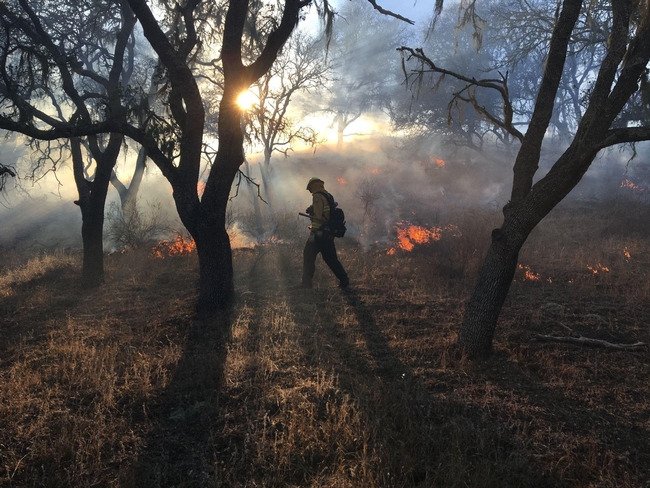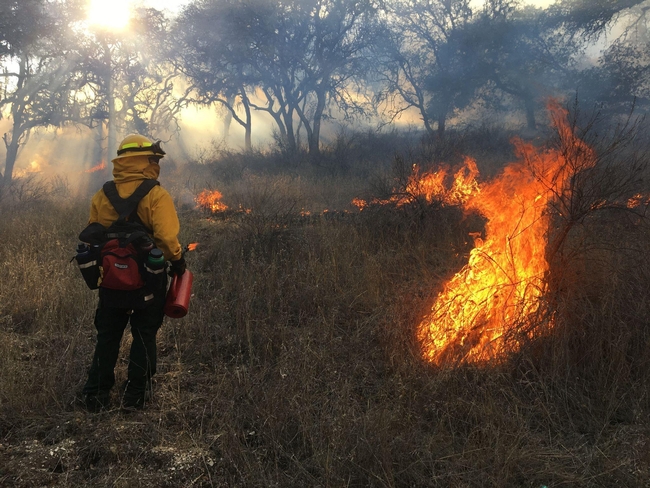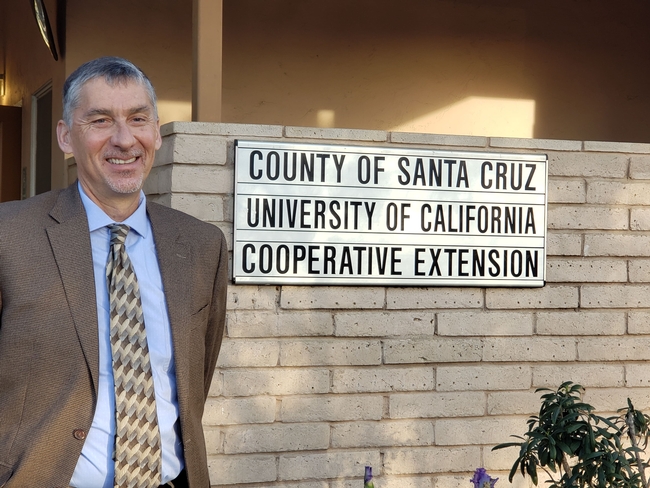Posts Tagged: San Benito
Lawn-pocalypse! Surviving Drought
Ah, summer! The season of sunburns, pool parties, and… lawn droughts. If your once lush, green carpet now looks like a crunchy brown doormat, you're not alone. Let's dive into why your yard is staging a dramatic death scene and what you can do to...

Bermuda grass and weeds overtaking drought stressed turf grass.
Fueling community knowledge: A conversation with UC ANR Fire Advisor Barb Satink Wolfson
In the wake of California's increasing wildfire concerns, UC ANR has made a concerted push to expand their fire network by hiring more academic advisors like...
Public invited to observe prescribed fire training June 4-9
The Monterey Bay area will host part of the first California Central Coast Prescribed Fire Training Exchange, or Cal-TREX.
Fire practitioners from across the state, greater North America and international locations (Spain, Honduras, Costa Rica, Ecuador) are gathering for a Prescribed Fire Training Exchange on June 3-10.
The training is hosted by the Central Coast Prescribed Burn Association, which empowers the public to build a culture of “good fire” and helps private landowners conduct prescribed burns in Monterey, San Benito and Santa Cruz counties.
Prescribed burns will be open for the public to observe on various days throughout the training, most likely June 4-9, depending on the weather. Please see the CCPBA webpage for updates on upcoming burns: http://calpba.org/centralcoastpba.
Prescribed Fire Training Exchanges (TREX) first came to Northern California in 2013, and have made a dynamic, positive cultural shift concerning prescribed fire, within both regional fire services and the general public. These “good fire” TREX events have drawn significant attention, especially in the context of more severe wildfire seasons.
After months of cross-organizational cooperative planning, participants in the weeklong training will be burning a mix of grassland, oak woodland and shrub vegetation types, and make a lasting, positive change concerning “good fire” on the Central Coast.
The TREX will provide experiential training opportunities to advance regional prescribed fire capacity, while also enhancing research to better understand the ecological response of wild plant and animal species following fire.
At this TREX event, participants will learn how to safely conduct prescribed burns in various vegetation types across three counties. Along with multiple prescribed burns, the weeklong program will include lectures and seminars on local fire ecology of plant and animal species, tribal burning practices and burn planning led by multiple burn bosses and other experts.
Burn locations may include the Nyland property (owned by Trust for Public Land and San Benito Agricultural Land Trust) near San Juan Bautista, the Santa Lucia Conservancy near Carmel Valley and the Kechun Village (owned by the Nason family) in Arroyo Seco.
Be advised, while the CCTREX works closely with the Monterey Bay Air Resources District (MBARD) to assure good smoke dispersal, smoke may be seen and present in these areas during and after a burn. Please see the CCPBA webpage for updates on upcoming burns: http://calpba.org/centralcoastpba.
BurnBot, a new technology featuring a mobile burn chamber, remote-controlled mastication and fire drone systems, will be used for the prescribed burn on June 4. To observe the Nyland burn on June 4, register at https://bit.ly/CCPBApublicRxfire. Details including time and directions will be emailed to registered participants.
Participants and partners include members of the Amah Mutsun Tribal Band and the Esselen Tribe of Monterey County, University of California Agriculture and Natural Resources, Resource Conservation District of Monterey County, CAL FIRE, local land trusts, scientists, ranchers, students, researchers, land managers and others. The CCPBA is funded by two CAL FIRE wildfire prevention grants.
For more information, contact Jamie Tuitele-Lewis, fire fuel mitigation program and forest health coordinator, at jtlewis@rcdmonterey.org or Barb Satink Wolfson, UC Cooperative Extension area fire advisor, at bsatinkwolfson@ucanr.edu.
Climate-Change Resources
University of California UC ANR Green Blog (Climate Change and Other Topics) https://ucanr.edu/blogs/Green/index.cfm?tagname=climate%20change (full index)
Examples:
- Save Trees First: Tips to Keep Them Alive Under Drought https://ucanr.edu/b/~CdD
- Landscaping with Fire Exposure in Mind: https://ucanr.edu/b/~G4D
- Cities in California Inland Areas Must Make Street Tree Changes to adapt to Future Climate https://ucanr.edu/b/~oF7
Drought, Climate Change and California Water Management Ted Grantham, UC Cooperative Extension specialist (23 minutes) https://youtu.be/dlimj75Wn9Q
Climate Variability and Change: Trends and Impacts on CA Agriculture Tapan Pathak, UC Cooperative Extension specialist (24 minutes) https://youtu.be/bIHI0yqqQJc
California Institute for Water Resources (links to blogs, talks, podcasts, water experts, etc.) https://ciwr.ucanr.edu/California_Drought_Expertise/
UC ANR Wildfire Resources (publications, videos, etc.) https://ucanr.edu/News/For_the_media/Press_kits/Wildfire/ (main website)
-UC ANR Fire Resources and Information https://ucanr.edu/sites/fire/ (main website)
-Preparing Home Landscaping https://ucanr.edu/sites/fire/Prepare/Landscaping/
UC ANR Free Publications https://anrcatalog.ucanr.edu/ (main website)
- Benefits of Plants to Humans and Urban Ecosystems: https://anrcatalog.ucanr.edu/pdf/8726.pdf
-Keeping Plants Alive Under Drought and Water Restrictions (English version) https://anrcatalog.ucanr.edu/pdf/8553.pdf
(Spanish version) https://anrcatalog.ucanr.edu/pdf/8628.pdf
- Use of Graywater in Urban Landscapes https://anrcatalog.ucanr.edu/pdf/8536.pdf
- Sustainable Landscaping in California https://anrcatalog.ucanr.edu/pdf/8504.pdf
Other (Non-UC) Climate Change Resources
Urban Forests and Climate Change. Urban forests play an important role in climate change mitigation and adaptation. Active stewardship of a community's forestry assets can strengthen local resilience to climate change while creating more sustainable and desirable places to live. https://www.fs.usda.gov/ccrc/topics/urban-forests
Examining the Viability of Planting Trees to Mitigate Climate Change (plausible at the forest level) https://climate.nasa.gov/news/2927/examining-the-viability-of-planting-trees-to-help-mitigate-climate-change/
Reports and other information resources coordinated under the auspices of the United Nations and produced through the collaboration of thousands of international scientists to provide a clear and up to date view of the current state of scientific knowledge relevant to climate change. United Nations Climate Action
Scientific reports, programs, action movements and events related to climate change. National Center for Atmospheric Research (National Science Foundation)
Find useful reports, program information and other documents resulting from federally funded research and development into the behavior of the atmosphere and related physical, biological and social systems. Search and find climate data from prehistory through to an hour ago in the world's largest climate data archive. (Formerly the "Climatic Data Center") National Centers for Environmental Information (NOAA)
Think tank providing information, analysis, policy and solution development for addressing climate change and energy issues (formerly known as the: "Pew Center on Global Climate Change"). Center for Climate & Energy Solutions (C2ES)
Mapping Resilience: A Blueprint for Thriving in the Face of Climate Disaster. The Climate Adaptation Knowledge Exchange (CAKE) was launched in July 2010 and is managed by EcoAdapt, a non-profit with a singular mission: to create a robust future in the face of climate change by bringing together diverse players to reshape planning and management in response to rapid climate change. https://www.cakex.org/documents/mapping-resilience-blueprint-thriving-face-climate-disaster
Cal-Adapt provides a way to explore peer-reviewed data that portrays how climate change might affect California at the state and local level. We make this data available through downloads, visualizations, and the Cal-Adapt API for your research, outreach, and adaptation planning needs. Cal-Adapt is a collaboration between state agency funding programs, university and private sector researchers https://cal-adapt.org/
Find reports, maps, data and other resources produced through a confederation of the research arms of 13 Federal departments and agencies that carry out research and develop and maintain capabilities that support the Nation's response to global change. Global Change (U.S. Global Change Research Program)
The Pacific Institute is a global water think tank that combines science-based thought leadership with active outreach to influence local, national, and international efforts to develop sustainable water policies. https://pacinst.org/our-approach/
Making equity real in climate adaptation and community resilience policies and programs: a guidebook. https://greenlining.org/publications/2019/making-equity-real-in-climate-adaption-and-community-resilience-policies-and-programs-a-guidebook/
Quarterly CA Climate Updates and CA Drought Monitor Maps (updated each Thursday) https://www.drought.gov/documents/quarterly-climate-impacts-and-outlook-western-region-june-2022
Gonzalves begins as new UC Cooperative Extension director for Monterey, Santa Cruz and San Benito counties
David Gonzalves started on Feb. 1 as director for University of California Cooperative Extension in Monterey, San Benito and Santa Cruz counties. UC Cooperative Extension connects communities across California with UC research and science-based solutions through agriculture, natural resources, nutrition and 4-H youth development programs.
Responsible for the overall operation of UCCE educational and applied research programs in the region, Gonzalves also will build and expand partnerships with county and city governments, public agencies and community organizations.
“David brings tremendous expertise in administration, fostering strong relationships, and building effective teams,” said Deanne Meyer, interim associate vice president for programs and strategic initiatives at UC Agriculture and Natural Resources, which administers UCCE statewide. “His track record of engaging local agencies, business partners, stakeholders and community groups will be invaluable as we explore new collaborations to reach and serve more Californians.”
Gonzalves was most recently a campus building official at UC Merced. Beginning his career at the County of Merced as a fire inspector, Gonzalves worked his way up to supervising building inspector and eventually assistant development services director. Then, for the City of Merced, he filled the role of chief building official and ultimately director of development services, leading the city's Building, Planning and Engineering teams. For three years, Gonzalves served as Tuolumne County's Community Resources Agency director.
“David's past experience as an administrator in county government and at UC Merced makes him the ideal candidate for the work we do at UCCE, as he has demonstrated success in being able to successfully negotiate these two worlds,” said Lynn Schmitt-McQuitty, interim director for county Cooperative Extension at UC ANR.
Gonzalves said he looks forward to meeting with county leaders, members of local boards, growers, UC Master Gardener volunteers, 4-H members and community members to learn how UC Cooperative Extension can help meet local needs.
“My big picture goal is to allow UCCE advisors, administrative teams and local county leaders to have a coordinated approach to our local challenges and successes,” Gonzalves said. “Our efforts will concentrate on freeing up our research teams' calendars to ensure they can continue producing cutting-edge accomplishments here in the tri-county area.”
Based at the UCCE Monterey County office in Salinas, Gonzalves can be reached at dgonzalves@ucanr.edu or (831) 392-5916.




